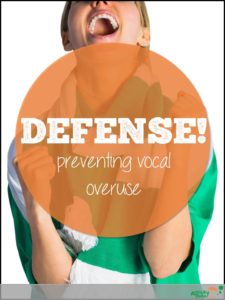Please welcome my guest blogger, Kristie Knickerbocker, MS, CCC-SLP!
The thunder of clapping hands and pounding feet in the bleachers…The flash of shimmering pom poms…The fight song blaring from the marching band’s tubas and horns. These images evoke memories of a time when our biggest problems were getting our homework in on time. At any age, we all have problems to solve. For some sport fans, voice problems develop from behaviors that could have been avoided, while they still enjoy cheering for their favorite teams.
The WHAT and the WHY: “First Down…”
I see a slew of patients who have attended football games, hockey games and pep rallies and developed vocal issues. These problems also pop up from long term, or chronic phonotrauma from overusing their voices in activities like cheerleading or coaching. Phonotrauma can be broken down into two parts– “Phono” means sound, and “trauma” means you’re doing some sort of damage. Although vocal overuse usually results in developing traumatic injury, we no longer like to refer to phonotrauma as vocal abuse. Voice issues that can be caused by a single instance of vocal overuse include polyps, hemorrhage or vocal cysts. These types of lesion are from an acute injury that might be caused from yelling too loudly. Chronic phonotrauma can result in granulomas or vocal fold nodules. Nodules are hard callouses that form on the vocal folds.
Diagnosis and Treatment: “Halftime”
If you notice a voice change that has lasted longer than 2 weeks, it is recommended that you see an otolaryngologist or Ear Nose Throat physician for an evaluation. It is possible that you have nothing to worry about, but to rule out something more serious it is best to get checked out. Should you have vocal issues that require a vocologist (or someone who specializes in rehabilitating the voice) you can locate one through the Pan-American Vocology Association.
Depending on your diagnosis, treatment can vary. Your physician may feel it is appropriate for a more conservative approach and set you up with a Speech-Language Pathologist who specializes in voice disorders. An example would be a diagnosis of vocal lesion or swelling, 4-6 sessions of voice rehabilitation, then a re-examination to determine if surgery is necessary to remove the lesion. Vocal nodules would respond best to voice rehabilitation, as the chronic phonotrauma is what caused them in the first place. It would do no good to cut them off without changing your behavior first.
Prevention, is it possible? “Touchdown!”
For both children and adults, it is difficult to monitor voice use in real time. Vocologists and SLP’s can encourage patients to do the following things to prevent acute injury:
- Use noise makers, whistling, clapping and/or stomping feet instead of cheering at sporting events. Teach those children how to whistle! Or just give them a whistle to wear around the neck! Adults can even be “that fan” with a large tub of rocks or a bell to add to the noise!
- Alter behaviors when communicating with others at sporting events, like talking or cheering with your abdomen muscles engaged to avoid producing sound from your throat. Go up to the player to talk when coaching if possible, instead of yelling across the field.
- Wear a portable amplifier when at these events. When you have to yell across the field, these things are cheap, have rechargeable batteries and the benefits are second-to-none. This one from Dime Tech is on Amazon for $39.99. Your voice will thank you.
- Wear earplugs during sporting events. Not only does this help protect hearing, but it helps reduce the Lombard Effect. This is when you automatically raise the volume of your voice when the back ground noise increases. The earplugs will actually help you hear yourself better.
- Above all, stay hydrated. Vocal folds vibrate so many times per second, heat from friction can do a number on the tissue making it swell. If you keep your water intake high, your vocal folds will have thin lubrication to keep that at bay. Avoid caffeine or alcohol, as both dry out tissue.
Encouraging athletes and fans (children or adults) to practice healthy vocal habits early on is key at reducing the number of chronic or acute vocal fold injuries. Here is a free resource to help make it fun for fans and athletes to remember good vocal health and hygiene. With education, we can all be fans, cheerleaders, players, and children on the playground with less of a chance of developing vocal issues. Go Team!
Kristie Knickerbocker, MS, CCC-SLP, is a speech-language pathologist and singing voice specialist in Fort Worth, Texas. She provides voice, swallowing and speech-language treatment in her private practice, a tempo Voice Center, and lectures on vocal health to area choirs and students. She also runs a mobile videostroboscopy and FEES company, Voice Diagnostix. She is an affiliate of ASHA Special Interest Group 3, Voice and Voice Disorders, and a member of the National Association of Teachers of Singing and the Pan-American Vocology Association. Knickerbocker blogs on her website at www.atempovoicecenter.com. She has developed a line of kid-friendly therapy materials specifically for voice on TPT or her website. Follow her on Pinterest, on Twitter and Instagram or like her on Facebook.






